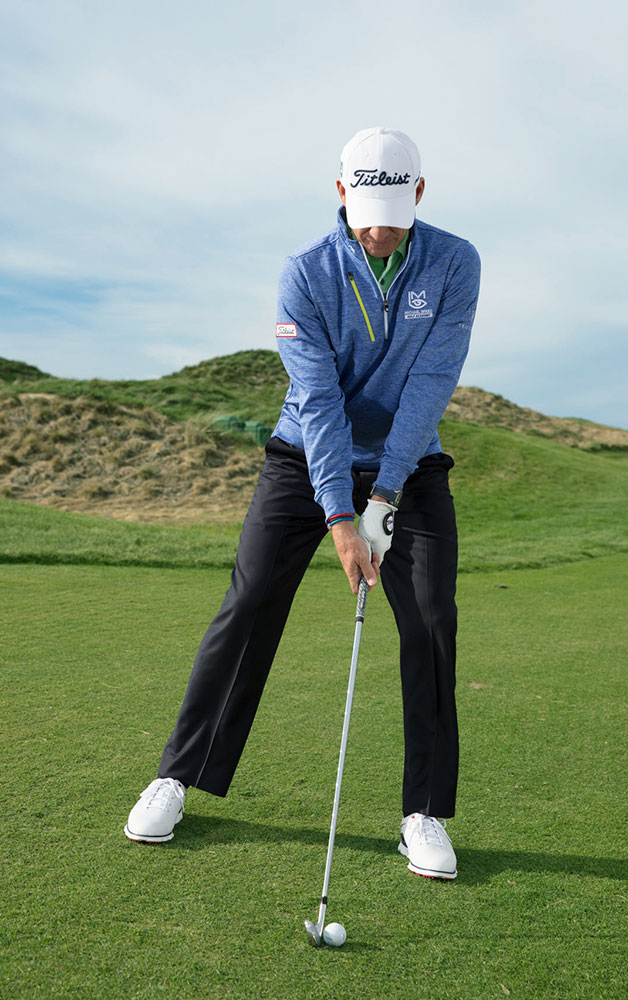Good golf is about playing as many par 3s as you can.
What does that mean? In addition to the actual par 3s on the course, your goal should be to have a reasonable “par 3” to the green after your tee shot on par 4s (or second shot on par 5s). If you drive it in the water or out-of-bounds, you don’t get to play a par 3. But from 150 in the fairway, you should be thinking, I can make 3 from here.
Driving is the first step in the process, but given at least a decent drive – assuming you’re playing from the right set of tees – it’s really more about what you do next. Think about it: what’s the most important shot on a par 3? It’s the shot to the green – the approach shot – because that’s what determines if you’ll be scoring or scrambling.
Let’s look at five common situations you face after your tee shot. I’ll give you playing tips and the swing keys for each one. Use my par-3 strategy, and you’ll play every hole better.
1. In The Fairway
Focus On Tempo And Solid Contact
If you don’t hit a lot of fairways, you probably feel oddly anxious when you do find one. First, don’t rush up to your ball and then have to wait. Stroll the last 50 paces or so. Ben Hogan used to prepare for his rounds by driving to the course at half speed. Point is, let your mind and body slow down. Next, a good word to focus on is “complete”. Think about completing the backswing and getting to a full finish. That means turning your body back and through [above], letting the swing take some time. Nerves usually speed things up, with the hands and arms taking over. Smooth tempo and a full motion will help you hit the ball flush – and follow up that piped drive.
 2. From The Rough
2. From The Rough
Predict the quality of the strike
Shots in the rough test judgment as much as skill. Some lies allow any shot; others require caution. Here’s a system I use to read them: imagine there’s a sock stretched over your club-head, and the thickness of the sock determines how crisply you strike the ball. A buried lie, where you get a lot of grass interference, is like hitting with a thick sock – a dead thud. Maybe you have to just pitch that one out. A medium lie is like a thin sock, so you might be able to play to the green. For most rough lies, you need a steeper angle of attack. Play the ball back and hinge your wrists sooner in the backswing [right]. Also, open the clubface a little to help it slide through the grass. Don’t lift the ball out. Elevate the clubhead on the backswing, not on the through-swing.
Safety first : Never Run A Red Light
One way to look at approach shots is to use a traffic-light analogy: red, yellow and green. Green means take dead aim. You like the lie, the distance, the shot. Red is a no-go situation usually requiring a punch-out or lay-up. Yellow is a judgment call, and these can turn to green when you’re feeling good or need to play aggressively – like when you’re down late in a match. But reds should never turn green, and this is where a lot of amateurs get into trouble. So hope for green lights, be cautious on yellows, and hit the brakes on the reds.
 3. Fairway Bunker
3. Fairway Bunker
Swing more with your arms
The No. 1 key to playing out of fairway bunkers is hitting the ball first. Let’s assume you can easily clear the lip in front of you. Some of the swing keys from the rough work here, too, because you want to make a little steeper downswing.
Positioning the ball slightly back from normal, opening the clubface, and hinging your wrists early are good points, but the shifty sand underfoot requires a couple more. Add flex in your lead knee – that will keep your weight forward and promote ball-first contact. Also, grip down on the club for control. Overall, think of the swing as more hands and arms and less body turn [left]. Because you’re taking power out of the swing, it’s a good idea to use one more club, as long as the lip isn’t an issue.
 4. Downhill Lie
4. Downhill Lie
Tilt your body with the slope
Of all the uneven lies you get, downhillers are the toughest. The reason is, you feel like you really have to help the ball into the air – and that’s a killer. The first step is to widen your stance and flare your lead foot for balance. Then, grip down on the club to counteract the lowering action of getting into a wide stance. The big key is tilting your hips and shoulders more with the slope [left]. You’ll never get them to match the angle of the hill, but that’s the feeling. A little more flex in your lead knee will help level your hips to the slope. What you shouldn’t do is play the ball back in your stance, like a lot of people think. That only makes you hit the ball lower – on a shot that’s already going to fly low. Instead, position the ball up in your stance and open the clubface to boost trajectory.
5. From Trouble
Plan for the next shot
 OK, this last one isn’t an approach shot, but I bring it up because many golfers try to turn it into one. When you hit a drive off the grid, have the discipline to just get back in play. Grab a wedge, and make a simple up-and-down swing.
OK, this last one isn’t an approach shot, but I bring it up because many golfers try to turn it into one. When you hit a drive off the grid, have the discipline to just get back in play. Grab a wedge, and make a simple up-and-down swing.
Three factors to consider:
- You want a level lie in the fairway for your next shot.
- Give yourself room for error on the recovery – don’t hit it into trouble on the other side.
- If possible, play to a distance you like. You probably want a full swing with one of your wedges, not something in between.
As with all these shots, be smart and keep the technique simple.
Michael Breed runs his golf academy at Trump Golf Links at Ferry Point in New York City and he spoke with with Peter Morrice.




